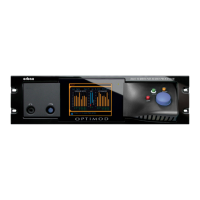OPTIMOD SURROUND PROCESSOR OPERATION
3-23
will cause an audio click. However, clicks can only occur if you switch dur-
ing active audio; you can prevent clicks by switching during silence like
the boundary between two program elements. The downside of using
non-flat equalization in P
ASS-THROUGH is that the equalization will color
the program material intended for “pass-through,” so it is usually not a
good idea—switching during silence is far preferable.
You can use the Loudness Controller to monitor and cap the maximum
subjective loudness of program material that would ordinarily be passed
through uncontrolled—a pathologically loud network commercial, for
example.
Note: L
ESS-MORE is not available in the PASS-THROUGH preset.
In addition to editing the factory PASS-THROUGH preset to create a pass-through user
preset, you can convert a two-band or five-band preset to pass-through mode. This
will retain the preset’s equalizer and loudness controller settings but will disable
other settings. To do this, L
OCATE to ADVANCED MODIFY>AGC and set the PASS SWITCH
control to I
N. To restore the preset’s full functionality, you can later set the PASS
SWITCH control to OUT.
Five-Band: The Five-Band structure is very flexible, enabling you to fine-tune your
on-air sound. All filters are phase-linear. Band 1 is lowpass, band 2 is highpass, and
the remaining bands are bandpass. The Band 1↔2 crossover frequency is switchable
between 100 and 200 Hz. The remaining crossover frequencies are fixed at 520 Hz,
1.8 kHz, and 6 kHz.
There are several Factory Presets for the Five-Band structure. You can edit these with
the L
ESS-MORE control. This control affects the sound-for-picture-oriented presets
differently than it does the music presets. When a sound-for-picture-oriented preset
is on the air, the L
ESS-MORE control adjusts the average amount of gain reduction by
adjusting the drive level to the Five-Band structure's input and adjusting the idle
gain—the amount of gain reduction in the AGC when it is gated. (It gates whenever
the input level to the AGC is below the setting of the AGC
GAT E THRESH control.)
However, L
ESS-More does not change the loudness controller threshold; it just
changes the amount of compression in the AGC and multiband compressor. Dialog
at normal levels will still be consistent with the setting of the 8685’s D
IALNORM pa-
rameter.
Hence, LESS-MORE determines how much the 8685 will amplify the loudness
of quiet parts of the input while ensuring that the program material does not be-
come unpleasantly loud.
When a music preset is on the air, the L
ESS-MORE control sets the amount of overall
processing, making optimum tradeoffs between loudness, brightness, and distor-
tion. In sound for picture, there are no loudness wars; for music presets, there is
probably never a need to advance the L
ESS-MORE control beyond 5.
Two-Band: The Two-Band structure is the same as the Five-Band structure except
that the Two-Band compressor sidechain controls the gains of the five bands. The
upper four bands are 100% coupled and are controlled by the Master output of the
sidechain, while the Bass output of the sidechain controls Band 1.
The Two-Band structure has an open, easy-to-listen-to sound that is similar to the
source material if the source material is of good quality. However, if the spectral

